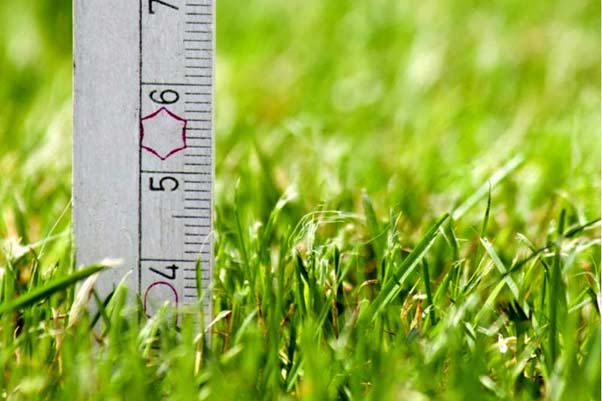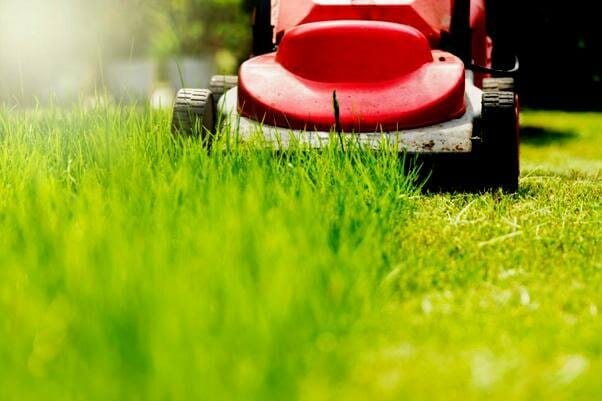Lawns need mowing regularly to keep them healthy, green, and luscious. How often you need to mow your lawn varies depending on the time of year and grass type.
On average you will need to mow a lawn once every 2 – 3 weeks. In summer when grass grows quicker, that is reduced to once every 10 – 14 days, while in winter you can stretch it out to once every 4 weeks.
Other factors that may vary how often you need to mow your lawn are the type of grass you have and the current weather conditions. We look at other factors below.
Does mowing make grass grow faster?

When lawn mowing is done right, with the right height maintained, yes, it makes the grass grow faster and healthier as it grows. This growth is also a function of the type/species of grass you have on your lawn and the season of the year; since grass grows faster during the warmer/hotter seasons of spring and summer.
Frequent mowing promotes grass growth through specific processes. Once trimmed, the entire system of the grass goes on an overdrive. To augment its growth and efficiently carry out photosynthesis, it propels itself. It focuses its energy on the blade and runner growth, expanding its growth both upwards and sideways, creating a canopy of green over the soil.
Does frequent mowing thicken grass?
In truth, yes, frequent mowing thickens grass by a good deal. The thickened grass happens because the frequency exposes the lower ends of the grass to open up more and absorb the necessary nutrients easily and swiftly. Photosynthesis takes place on a more frequent level, thereby enriching the grass blades and fortifying them.
Some of the reasons why frequent mowing thickens grass are:
- It rids the grass of pests: Constant mowing at the right time rids the grass of insects and pests that use the elongated blades as home to breed and procreate, and also as a source of food, thereby transmitting diseases to the body. A frequently mowed grass is free from all that and, therefore, has the space to grow freely and healthily.
- It thickens near the root: Since the primary nutrients are grassroots, grass growing near the roots will thicken more as it can access the necessary nutrients for even and healthy growth. Frequently trimmed lawns have more sunlight access, and photosynthesis is better, meaning more nutrients to absorb. As the grass benefits from the frequent mowing leading to its thickening, the thickened grass also benefits the homeowner. Some of these benefits include:
- Beautifies your lawn: As expected, the goal of a well-trimmed lawn is for beauty. Thickened grass adds more beauty to the yard with its lush fullness and bright greenery due to its easy access to nutrients. The beauty of thickened grass appeals to the eyes, brightens up the looks of the entire lawn, and adds life to the home’s surroundings.
- Helps prevent soil erosion: Since thickened grass is closer to the soil, leaving little or no space for exposed soil, and its roots are firmer and healthier, holding the ground compactly together, erosion has little to no place of action. The roots absorb the excess water, and muddy areas are less predominant in such areas since the roots hold the soil together and reduce free space for water to stagnate.
- It purifies the air: Healthy thickened grass engages in photosynthesis daily, taking carbon dioxide in and releasing fresh and purified oxygen for you to enjoy. Like plants, the grass in your lawn act as cleaner and filter, sieving any pollutant in the air and giving you only clean and fresh air to enjoy.
Is it better to cut the grass short or long?
It’s always better to cut your grass long, at least for most of the year, and proceed to cut short towards the end of the year, i.e. during the winter months. Ideally, when mowing your lawn, the perfect height for your lawn grass is between 2 ½ inches to 3 inches, or as it’s popularly known, the one-third rule of cutting.
Avoid mowing the grass too low as you’ll cause the grass to lose its distributary power; this is in the sense that there is a balance between the roots and the blade, enabling the real grass to evenly grow out without straining itself to oversupply or work overtime. By maintaining this stipulated height between the top and the roots, the grass grows well. Otherwise, anything shorter than that is putting your lawn at risk of many things, including weak growth, soil erosion, insect infestation, and weak roots.
When considering the ideal height to cut your grass, consider the grass’s type/species as each type has a perfect healthy length for optimum standard. Finding out the perfect height will let you know if the one-third rule of cutting applies or if you’ll have to improvise in increasing the size or not.
What time of day should you cut grass?
The best times of the day to work on mowing your lawn is by mid-morning and late afternoon. Although you could still mow your lawn early in the morning or late in the evening, the best time is simply mid-morning and late afternoon. The reasons for these are simple. The Mid-morning period has the lawn less humid with the early dew and irrigation evaporated, and the grass is alive, giving you a proper way to gauge the depth of your cuts evenly over all areas.
Late afternoon is another perfect time because the heat of the day is over, spearing the grass, the mower, and yourself the stress of toiling under the hot scorching sun. This time is also highly appreciated because it allows the grass to repair and heal itself before the day runs out. Cutting in the late afternoon prevents the newly trimmed lawn from infectious spreading, often occurring in the dark of the evening/night.
What is the best height for grass?

As pointed out earlier, the best mowing height for grass is dependent on the type of grass present on your lawn. Since particular grass types have distinct peaks in which they thrive better. It’s best to look up the class and what the standard height is meant to be to reward yourself with a beautiful and lush-looking lawn at all times.
In that sense, you should know that there are cool-season grass types such as fescues and Kentucky bluegrass, which grow best in colder seasons, have an average height range between 1-4 inches. In contrast, there are the warm-season grass types such as St. Augustine, Bermuda, centipede, and zoysia, which grow best in the warmer and hotter seasons, they thrive with an average height range of 0.75-3 inches.
Follow these season type and height preferences, and your lawn will always look impeccably beautiful to every eye that beholds it.
Is it ok to cut your grass in hot weather?

Point blank, the answer is no. Mowing your lawn in hot weather is merely placing your grass at risk of many things like infection spreading, uneven cutting, and leaving your grass weakened. The best time to mow your lawn is late mid-morning when the sun is down, and the grass is dry, thereby avoiding damage to the property.
Cutting grass in hot weather is dangerous for the grass itself, but it doesn’t mean that it is impossible to achieve. There are still ways to give your grass some trimming without causing damage and risks. To achieve that, adjust your lawn-mower deck’s height that houses the blades is, use sharp edges and blades, and prepare to clean out clumped clippings from the freshly cut wet grass. But note that this is for when you have no other way out.
When not to mow your lawn
As emphasized earlier, the least favorable times to mow your lawn are early in the morning from 6-8 am, mid-day from 2-4 pm, and early evening from 6-8 pm. Early in the morning, the grass is damp from dew and irrigation. Mowing at such a time means uneven cutting and intense heat that wears both the grass and yourself out.
Mid-day means you’ll have to face the heat of the day, and so would the grass, causing it stress and suffering, and although it’s not so bad, it’s not the best mowing time. And early evening is the recovery time of the grass from the daily sun and stress; cutting at such a recovery time is extra dangerous for your lawn. Not only will it be extra weak, but it will be more susceptible to fungus and infections.
The average cost to cut a lawn
If you are not up for the mowing stress, you can hire a professional to do all that. The cost to cut a lawn varies based on the compound’s size, the number of laborers involved, and the timeframe (hourly, weekly, and monthly).
On average, it costs $60-$90 per man and per hour to mow a lawn of a reasonable size. The average will be $30-$45 per hour for a small/suitable lawn area at a lower cost range. At a medium range, it’s $60-$80/$90, and for a high-cost range, you’ll have $100-$120 per hour for a large lawn area. However, it is important to note that you should not neglect grass overgrowth, as in some states there is a fine for not cutting grass and letting it grow wild.
Conclusion
When you consider the aesthetic importance and value of a lawn to any home, its maintenance is paramount. Knowing the frequency to which you should mow, the best time to trim, the effects of cutting on the grass’s thickness and height, and the average cost you require to get the job done go a long way in the overall lawn maintenance.






